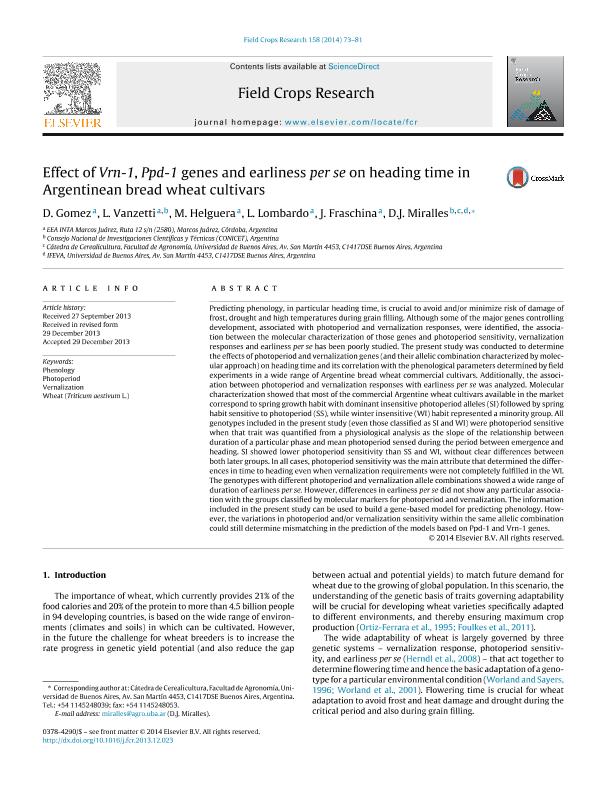Mostrar el registro sencillo del ítem
dc.contributor.author
Gomez, Dionisio Tomas
dc.contributor.author
Vanzetti, Leonardo Sebastián

dc.contributor.author
Helguera, Marcelo
dc.contributor.author
Lombardo, Lucio Andrés

dc.contributor.author
Fraschina, Jimena

dc.contributor.author
Miralles, Daniel Julio

dc.date.available
2016-02-04T20:30:04Z
dc.date.issued
2014-03
dc.identifier.citation
Gomez, Dionisio Tomas; Vanzetti, Leonardo Sebastián; Helguera, Marcelo; Lombardo, Lucio Andrés; Fraschina, Jimena; et al.; Effect of Vrn-1, Ppd-1 genes and earliness per se on heading time in Argentinean bread wheat cultivars; Elsevier; Field Crops Research; 158; 3-2014; 73-81
dc.identifier.issn
0378-4290
dc.identifier.uri
http://hdl.handle.net/11336/4030
dc.description.abstract
Predicting phenology, in particular heading time, is crucial to avoid and/or minimize risk of damage offrost, drought and high temperatures during grain filling. Although some of the major genes controllingdevelopment, associated with photoperiod and vernalization responses, were identified, the associationbetween the molecular characterization of those genes and photoperiod sensitivity, vernalizationresponses and earliness per se has been poorly studied. The present study was conducted to determinethe effects of photoperiod and vernalization genes (and their allelic combination characterized by molecularapproach) on heading time and its correlation with the phenological parameters determined by fieldexperiments in a wide range of Argentine bread wheat commercial cultivars. Additionally, the associationbetween photoperiod and vernalization responses with earliness per se was analyzed. Molecularcharacterization showed that most of the commercial Argentine wheat cultivars available in the marketcorrespond to spring growth habit with dominant insensitive photoperiod alleles (SI) followed by springhabit sensitive to photoperiod (SS), while winter insensitive (WI) habit represented a minority group. Allgenotypes included in the present study (even those classified as SI and WI) were photoperiod sensitivewhen that trait was quantified from a physiological analysis as the slope of the relationship betweenduration of a particular phase and mean photoperiod sensed during the period between emergence andheading. SI showed lower photoperiod sensitivity than SS and WI, without clear differences betweenboth later groups. In all cases, photoperiod sensitivity was the main attribute that determined the differencesin time to heading even when vernalization requirements were not completely fulfilled in the WI.The genotypes with different photoperiod and vernalization allele combinations showed a wide range ofduration of earliness per se. However, differences in earliness per se did not show any particular associationwith the groups classified by molecular markers for photoperiod and vernalization. The informationincluded in the present study can be used to build a gene-based model for predicting phenology. However,the variations in photoperiod and/or vernalization sensitivity within the same allelic combinationcould still determine mismatching in the prediction of the models based on Ppd-1 and Vrn-1 genes.
dc.format
application/pdf
dc.language.iso
eng
dc.publisher
Elsevier

dc.rights
info:eu-repo/semantics/openAccess
dc.rights.uri
https://creativecommons.org/licenses/by-nc-sa/2.5/ar/
dc.subject
Phenology
dc.subject
Photoperiod
dc.subject
Vernalization
dc.subject
Wheat
dc.subject.classification
Agronomía, reproducción y protección de plantas

dc.subject.classification
Agricultura, Silvicultura y Pesca

dc.subject.classification
CIENCIAS AGRÍCOLAS

dc.title
Effect of Vrn-1, Ppd-1 genes and earliness per se on heading time in Argentinean bread wheat cultivars
dc.type
info:eu-repo/semantics/article
dc.type
info:ar-repo/semantics/artículo
dc.type
info:eu-repo/semantics/publishedVersion
dc.date.updated
2016-03-30 10:35:44.97925-03
dc.journal.volume
158
dc.journal.pagination
73-81
dc.journal.pais
Países Bajos

dc.journal.ciudad
Amsterdam
dc.description.fil
Fil: Gomez, Dionisio Tomas. Instituto Nacional de Tecnología Agropecuaria. Centro Regional Córdoba. Estación Experimental Agropecuario Marcos Juarez; Argentina
dc.description.fil
Fil: Vanzetti, Leonardo Sebastián. Instituto Nacional de Tecnología Agropecuaria. Centro Regional Córdoba. Estación Experimental Agropecuario Marcos Juarez; Argentina
dc.description.fil
Fil: Helguera, Marcelo. Instituto Nacional de Tecnología Agropecuaria. Centro Regional Córdoba. Estación Experimental Agropecuario Marcos Juarez; Argentina
dc.description.fil
Fil: Lombardo, Lucio Andrés. Instituto Nacional de Tecnología Agropecuaria. Centro Regional Córdoba. Estación Experimental Agropecuario Marcos Juarez; Argentina
dc.description.fil
Fil: Fraschina, Jimena. Instituto Nacional de Tecnología Agropecuaria. Centro Regional Córdoba. Estación Experimental Agropecuario Marcos Juarez; Argentina
dc.description.fil
Fil: Miralles, Daniel Julio. Consejo Nacional de Investigaciones Científicas y Técnicas. Oficina de Coordinación Administrativa Parque Centenario. Instituto de Investigaciones Fisiológicas y Ecológicas Vinculadas a la Agricultura; Argentina. Universidad de Buenos Aires. Facultad de Agronomía. Departamento de Producción Vegetal. Cátedra de Cerealicultura; Argentina
dc.journal.title
Field Crops Research

dc.relation.alternativeid
info:eu-repo/semantics/altIdentifier/url/http://www.sciencedirect.com/science/article/pii/S0378429013004371
dc.relation.alternativeid
info:eu-repo/semantics/altIdentifier/url/http://dx.doi.org/10.1016/j.fcr.2013.12.023
dc.relation.alternativeid
info:eu-repo/semantics/altIdentifier/url/0378-4290
Archivos asociados
